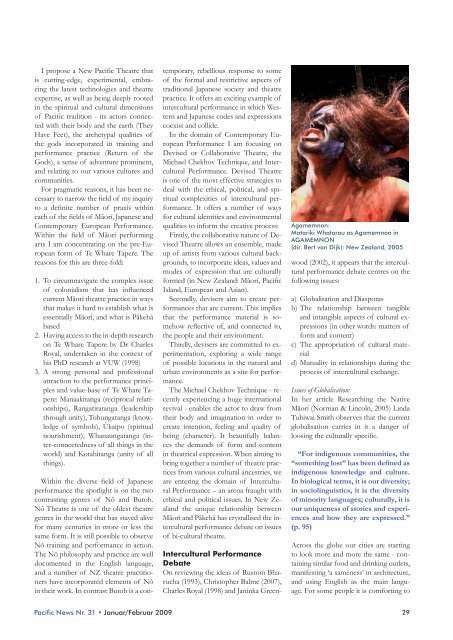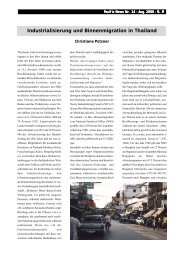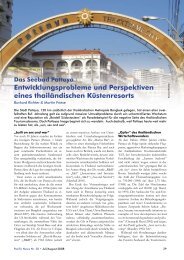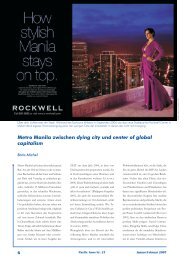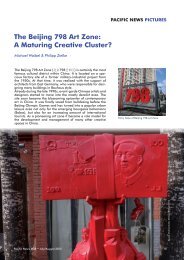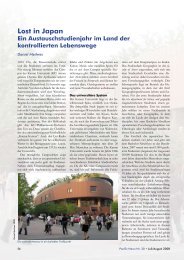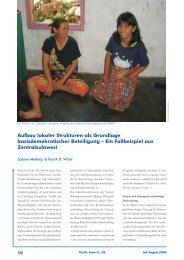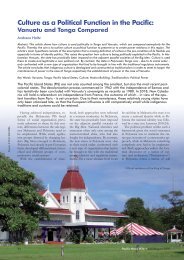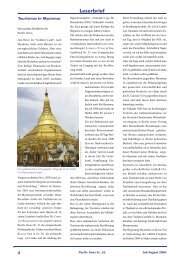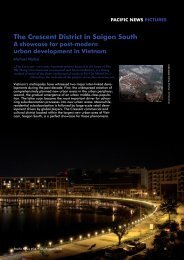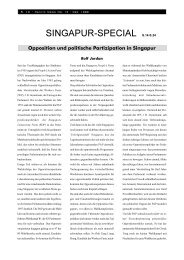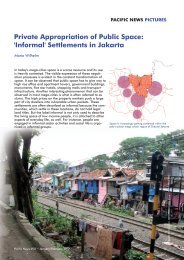Towards a New Pacific Theatre
Towards a New Pacific Theatre
Towards a New Pacific Theatre
You also want an ePaper? Increase the reach of your titles
YUMPU automatically turns print PDFs into web optimized ePapers that Google loves.
I propose a <strong>New</strong> <strong>Pacific</strong> <strong>Theatre</strong> that<br />
is cutting-edge, experimental, embracing<br />
the latest technologies and theatre<br />
expertise, as well as being deeply rooted<br />
in the spiritual and cultural dimensions<br />
of <strong>Pacific</strong> tradition - its actors connected<br />
with their body and the earth (They<br />
Have Feet), the archetypal qualities of<br />
the gods incorporated in training and<br />
performance practice (Return of the<br />
Gods), a sense of adventure prominent,<br />
and relating to our various cultures and<br />
communities.<br />
For pragmatic reasons, it has been necessary<br />
to narrow the field of my inquiry<br />
to a definite number of praxis within<br />
each of the fields of Mãori, Japanese and<br />
Contemporary European Performance.<br />
Within the field of Mãori performing<br />
arts I am concentrating on the pre-European<br />
form of Te Whare Tapere. The<br />
reasons for this are three-fold:<br />
1. To circumnavigate the complex issue<br />
of colonialism that has influenced<br />
current Mãori theatre practice in ways<br />
that makes it hard to establish what is<br />
essentially Mãori, and what is Pãkehã<br />
based<br />
2. Having access to the in-depth research<br />
on Te Whare Tapere by Dr Charles<br />
Royal, undertaken in the context of<br />
his PhD research at VUW (1998)<br />
3. A strong personal and professional<br />
attraction to the performance principles<br />
and value-base of Te Whare Tapere:<br />
Manaakitanga (reciprocal relationships),<br />
Rangatiratanga (leadership<br />
through unity), Tohungatanga (knowledge<br />
of symbols), Ûkaipo (spiritual<br />
nourishment), Whanaungatanga (inter-connectedness<br />
of all things in the<br />
world) and Kotahitanga (unity of all<br />
things).<br />
Within the diverse field of Japanese<br />
performance the spotlight is on the two<br />
contrasting genres of Nõ and Butoh.<br />
Nõ <strong>Theatre</strong> is one of the oldest theatre<br />
genres in the world that has stayed alive<br />
for many centuries in more or less the<br />
same form. It is still possible to observe<br />
Nõ training and performance in action.<br />
The Nõ philosophy and practice are well<br />
documented in the English language,<br />
and a number of NZ theatre practitioners<br />
have incorporated elements of Nõ<br />
in their work. In contrast Butoh is a contemporary,<br />
rebellious response to some<br />
of the formal and restrictive aspects of<br />
traditional Japanese society and theatre<br />
practice. It offers an exciting example of<br />
intercultural performance in which Western<br />
and Japanese codes and expressions<br />
coexist and collide.<br />
In the domain of Contemporary European<br />
Performance I am focusing on<br />
Devised or Collaborative <strong>Theatre</strong>, the<br />
Michael Chekhov Technique, and Intercultural<br />
Performance. Devised <strong>Theatre</strong><br />
is one of the most effective strategies to<br />
deal with the ethical, political, and spiritual<br />
complexities of intercultural performance.<br />
It offers a number of ways<br />
for cultural identities and environmental<br />
qualities to inform the creative process:<br />
Firstly, the collaborative nature of Devised<br />
<strong>Theatre</strong> allows an ensemble, made<br />
up of artists from various cultural backgrounds,<br />
to incorporate ideas, values and<br />
modes of expression that are culturally<br />
formed (in <strong>New</strong> Zealand: Mãori, <strong>Pacific</strong><br />
Island, European and Asian).<br />
Secondly, devisers aim to create performances<br />
that are current. This implies<br />
that the performance material is somehow<br />
reflective of, and connected to,<br />
the people and their environment.<br />
Thirdly, devisers are committed to experimentation,<br />
exploring a wide range<br />
of possible locations in the natural and<br />
urban environments as a site for performance.<br />
The Michael Chekhov Technique - recently<br />
experiencing a huge international<br />
revival - enables the actor to draw from<br />
their body and imagination in order to<br />
create intention, feeling and quality of<br />
being (character). It beautifully balances<br />
the demands of form and content<br />
in theatrical expression. When aiming to<br />
bring together a number of theatre practices<br />
from various cultural ancestries, we<br />
are entering the domain of Intercultural<br />
Performance – an arena fraught with<br />
ethical and political issues. In <strong>New</strong> Zealand<br />
the unique relationship between<br />
Mãori and Pãkehã has crystallised the intercultural<br />
performance debate on issues<br />
of bi-cultural theatre.<br />
Agamemnon:<br />
Matariki Whatarau as Agamemnon in<br />
AGAMEMNON<br />
(dir. Bert van Dijk): <strong>New</strong> Zealand, 2005<br />
Intercultural Performance<br />
Debate<br />
On reviewing the ideas of Rustom Bharucha<br />
(1993), Christopher Balme (2007),<br />
Charles Royal (1998) and Janinka Greenwood<br />
(2002), it appears that the intercultural<br />
performance debate centres on the<br />
following issues:<br />
a) Globalisation and Diasporas<br />
b) The relationship between tangible<br />
and intangible aspects of cultural expressions<br />
(in other words: matters of<br />
form and content)<br />
c) The appropriation of cultural material<br />
d) Mutuality in relationships during the<br />
process of intercultural exchange.<br />
Issues of Globalisation:<br />
In her article Researching the Native<br />
Mãori (Norman & Lincoln, 2005) Linda<br />
Tuhiwai Smith observes that the current<br />
globalisation carries in it a danger of<br />
loosing the culturally specific.<br />
“For indigenous communities, the<br />
“something lost” has been defined as<br />
indigenous knowledge and culture.<br />
In biological terms, it is our diversity;<br />
in sociolinguistics, it is the diversity<br />
of minority languages; culturally, it is<br />
our uniqueness of stories and experiences<br />
and how they are expressed.”<br />
(p. 95)<br />
Across the globe our cities are starting<br />
to look more and more the same - containing<br />
similar food and drinking outlets,<br />
manifesting ‘a sameness’ in architecture,<br />
and using English as the main language.<br />
For some people it is comforting to<br />
<strong>Pacific</strong> <strong>New</strong>s Nr. 31 • Januar/Februar 2009<br />
29


